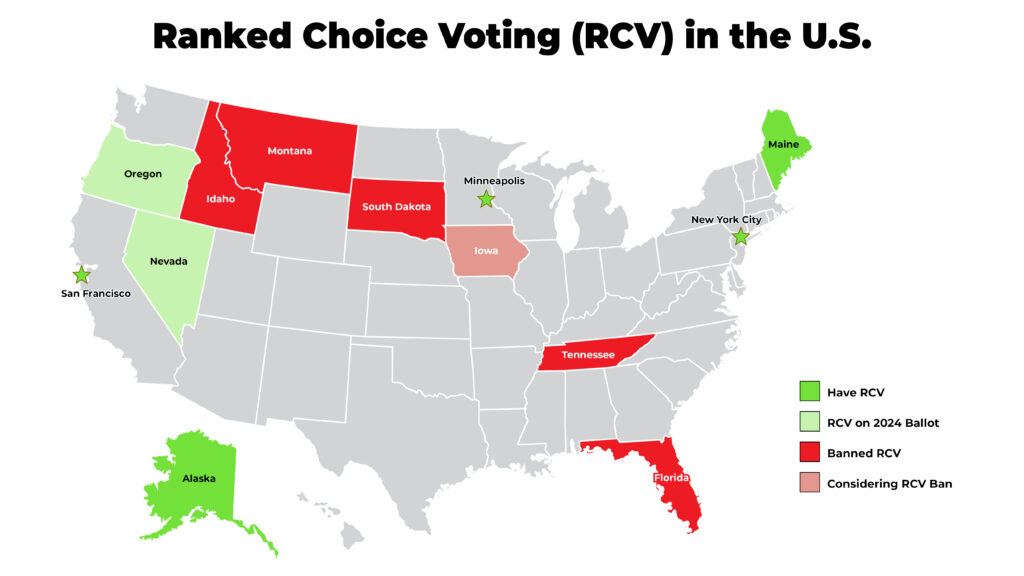We should not be abandoning a straight-forward system that everyone understands in exchange for a new, convoluted one filled with complications.
The adoption of Ranked Choice Voting (RCV) in various jurisdictions across the country has been touted as an improvement to the traditional voting system. Some RCV supporters even believe it will protect the United States from the demise of democracy. However, a closer look at RCV reveals several significant flaws that raise concerns about its complexity, effectiveness, and fairness. Iowa voters should be extremely skeptical of buying what Ranked Choice Voting proponents are trying to sell them.
RCV is an election system that requires voters to rank candidates in order of their preference instead of voting for just one candidate. Typically, when the votes are counted, if no candidate has more than 50% of the first-choice votes, the candidate with the fewest votes is eliminated. Voters who selected the eliminated candidate as their first choice then have their votes reallocated to their next preferred candidate. This process is repeated until a majority of the votes have been allocated to a single candidate, who is then declared the winner.
Currently, Alaska and Maine are the only two states that employ RCV for statewide elections, though voters in Nevada and Oregon may weigh in on the issue during elections in those states this fall. Meanwhile, legislatures in Florida, Idaho, Montana, South Dakota and Tennessee have all banned ranked choice voting in their states, and Iowa lawmakers are considering a similar measure right now. At the local level, voters in approximately 50 cities including New York City, Minneapolis, and San Francisco use RCV for their local elections.

One of the primary criticisms of RCV is the complexity it adds to the voting process. Unlike the straightforward (and time-tested) method of voters picking a single, favorite candidate, RCV requires voters to evaluate and rank all candidates on the ballot. This demands more time and effort, and in theory it asks the voter to learn about every candidate. The added burden of having to rank multiple candidates may overwhelm some voters, particularly those who are less engaged with the political process. The fear of making a mistake or the perception that the system is too complicated could deter potential voters from even participating.
Additionally, the RCV system is susceptible to voter errors, such as overvoting, where a voter might accidentally assign the same rank to multiple candidates. Such mistakes can lead to a ballot being declared invalid, calling to mind the debacle of hanging chads and other discrepancies from the 2000 presidential election. A voting system that can easily trip-up a voter and otherwise sideline their voice only serves to exclude part of the electorate. This risk is particularly concerning in a political process where every vote is supposed to count.
The potential for confusion extends beyond the voting process to the administration of elections and the counting and tabulation of the votes themselves. RCV can result in prolonged election outcomes, as seen in states like Alaska, where the final results for significant races were delayed for weeks. Such delays not only test the patience of the public but they also undermine trust in the electoral system, fueling speculation and discontent.
Another critical issue with RCV is the possibility of “exhausted” ballots, where a voter’s preferences are all eliminated before the final round of counting. This can occur if a voter does not rank all the candidates or if their top choices are among the first to be eliminated. Such voters effectively lose their voice in the latter stages of the election, which contradicts our nation’s fundamental democratic election principles.
American voters should not be abandoning a straight-forward system that everyone understands in exchange for a new, convoluted one filled with complications. For those who care about elections and the political process, the goal should be one voter, one ballot, and a clear paper trail. Any changes should be focused on improving voter education in general and encouraging participation within the existing system.
When new gimmicks are introduced, they only bring complications and more opportunities for error and fraud, leading voters to question the entire system. The set of problems RCV creates cannot be overlooked: the potential for confusion, the risk of disenfranchising voters, and the likelihood of protracted election results are all significant drawbacks. Our system of elections needs to inspire confidence in the integrity of the process and the accuracy of the outcomes.
